Strategic Financial Management Report: Penco's Investment Strategies
VerifiedAdded on 2023/01/09
|17
|5641
|94
Report
AI Summary
This report analyzes strategic financial management, focusing on investment decisions for Penco, a small pension fund company. It examines the financial performance of supermarket chains Sainsbury's and Mark & Spencer, recommending investment in M&S based on financial ratios and profitability. The report explores short-term and long-term financing needs, detailing various sources such as commercial paper and equity funding. It also discusses cost accounting concepts, tools, and budgeting processes, including the development of a master budget and evaluation of budgetary processes. The report emphasizes the importance of due diligence in investment decisions and the use of management information systems for strategic planning. Ultimately, the report provides a comprehensive overview of financial management strategies to improve investment outcomes for Penco.
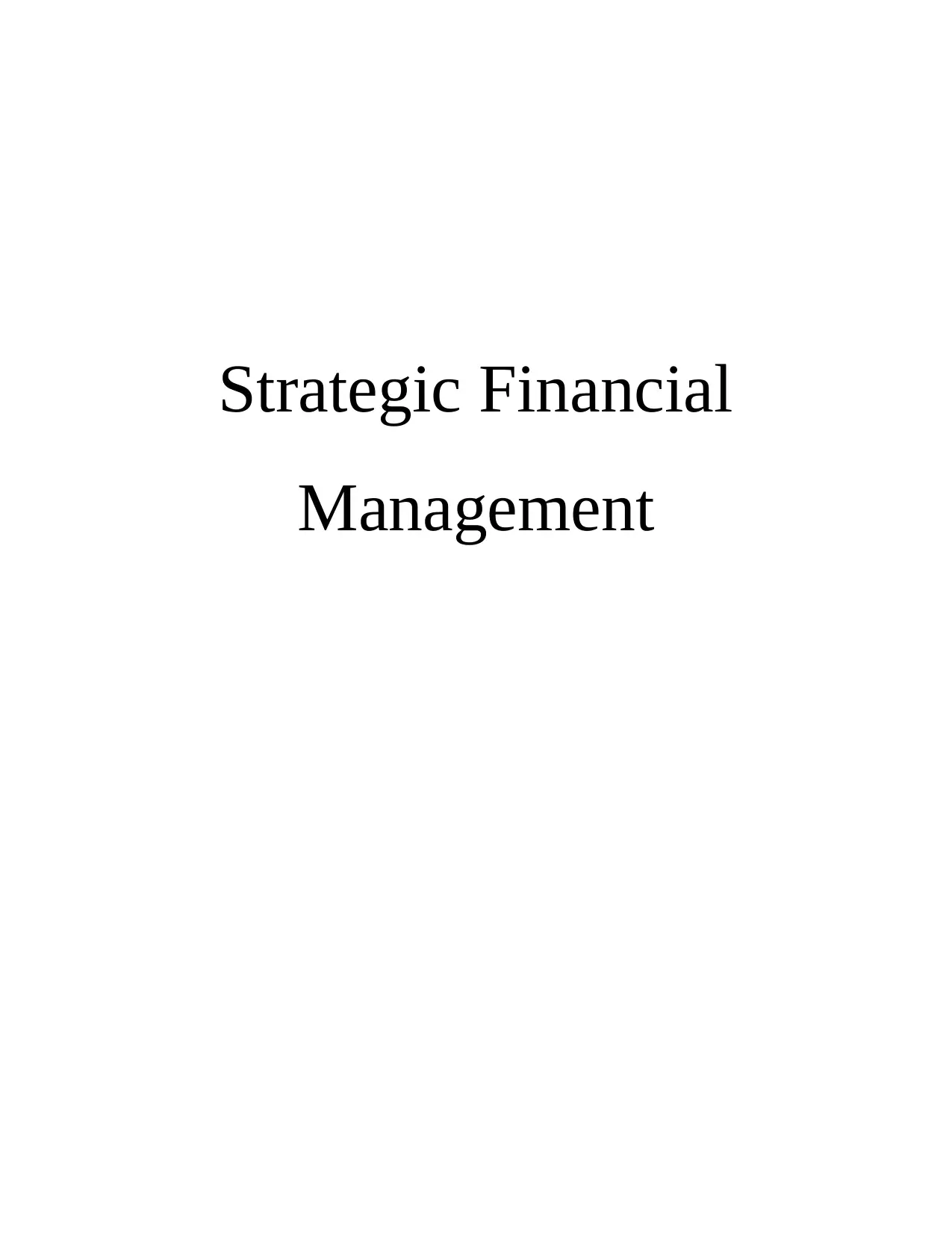
Strategic Financial
Management
Management
Paraphrase This Document
Need a fresh take? Get an instant paraphrase of this document with our AI Paraphraser
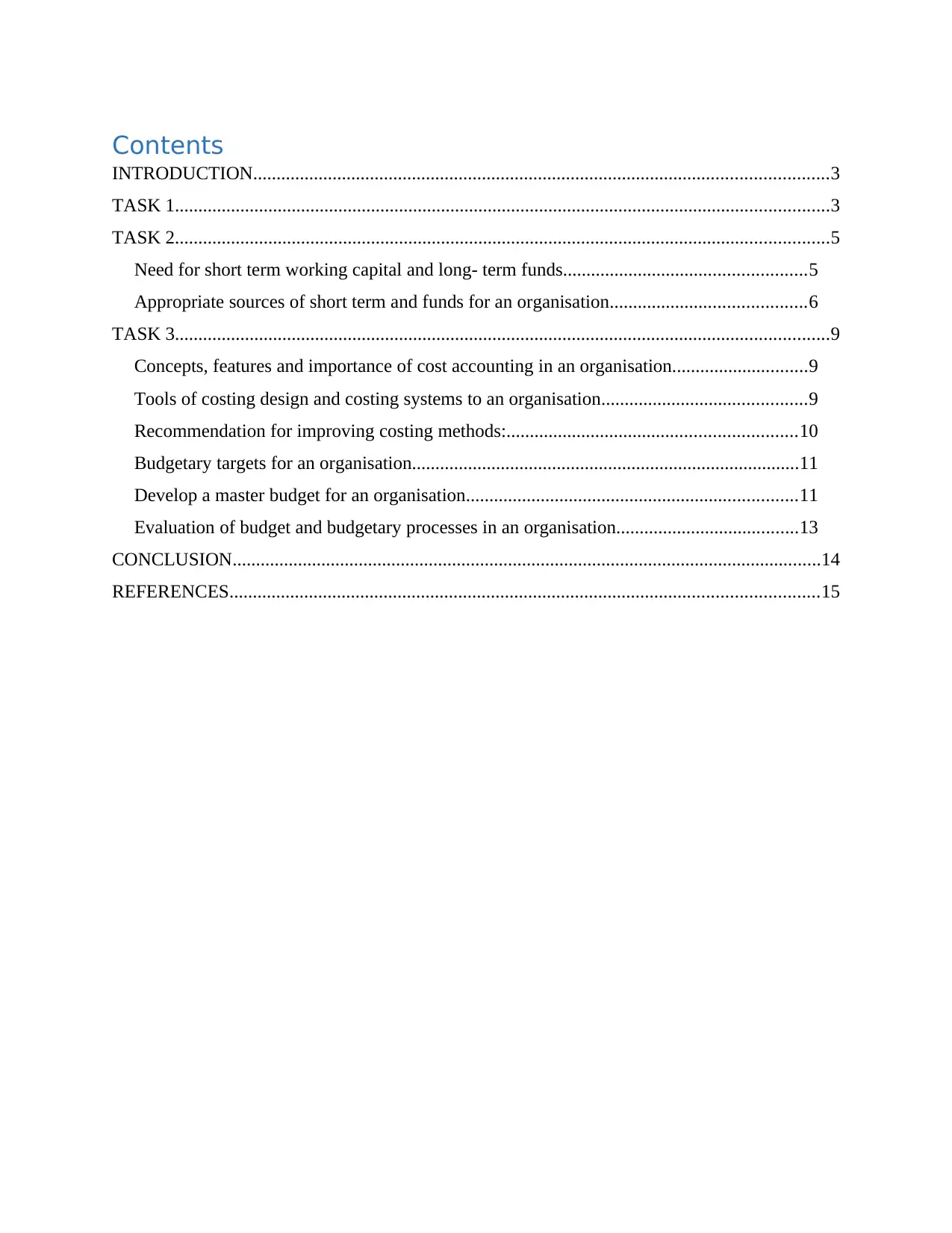
Contents
INTRODUCTION...........................................................................................................................3
TASK 1............................................................................................................................................3
TASK 2............................................................................................................................................5
Need for short term working capital and long- term funds....................................................5
Appropriate sources of short term and funds for an organisation..........................................6
TASK 3............................................................................................................................................9
Concepts, features and importance of cost accounting in an organisation.............................9
Tools of costing design and costing systems to an organisation............................................9
Recommendation for improving costing methods:..............................................................10
Budgetary targets for an organisation...................................................................................11
Develop a master budget for an organisation.......................................................................11
Evaluation of budget and budgetary processes in an organisation.......................................13
CONCLUSION..............................................................................................................................14
REFERENCES..............................................................................................................................15
INTRODUCTION...........................................................................................................................3
TASK 1............................................................................................................................................3
TASK 2............................................................................................................................................5
Need for short term working capital and long- term funds....................................................5
Appropriate sources of short term and funds for an organisation..........................................6
TASK 3............................................................................................................................................9
Concepts, features and importance of cost accounting in an organisation.............................9
Tools of costing design and costing systems to an organisation............................................9
Recommendation for improving costing methods:..............................................................10
Budgetary targets for an organisation...................................................................................11
Develop a master budget for an organisation.......................................................................11
Evaluation of budget and budgetary processes in an organisation.......................................13
CONCLUSION..............................................................................................................................14
REFERENCES..............................................................................................................................15
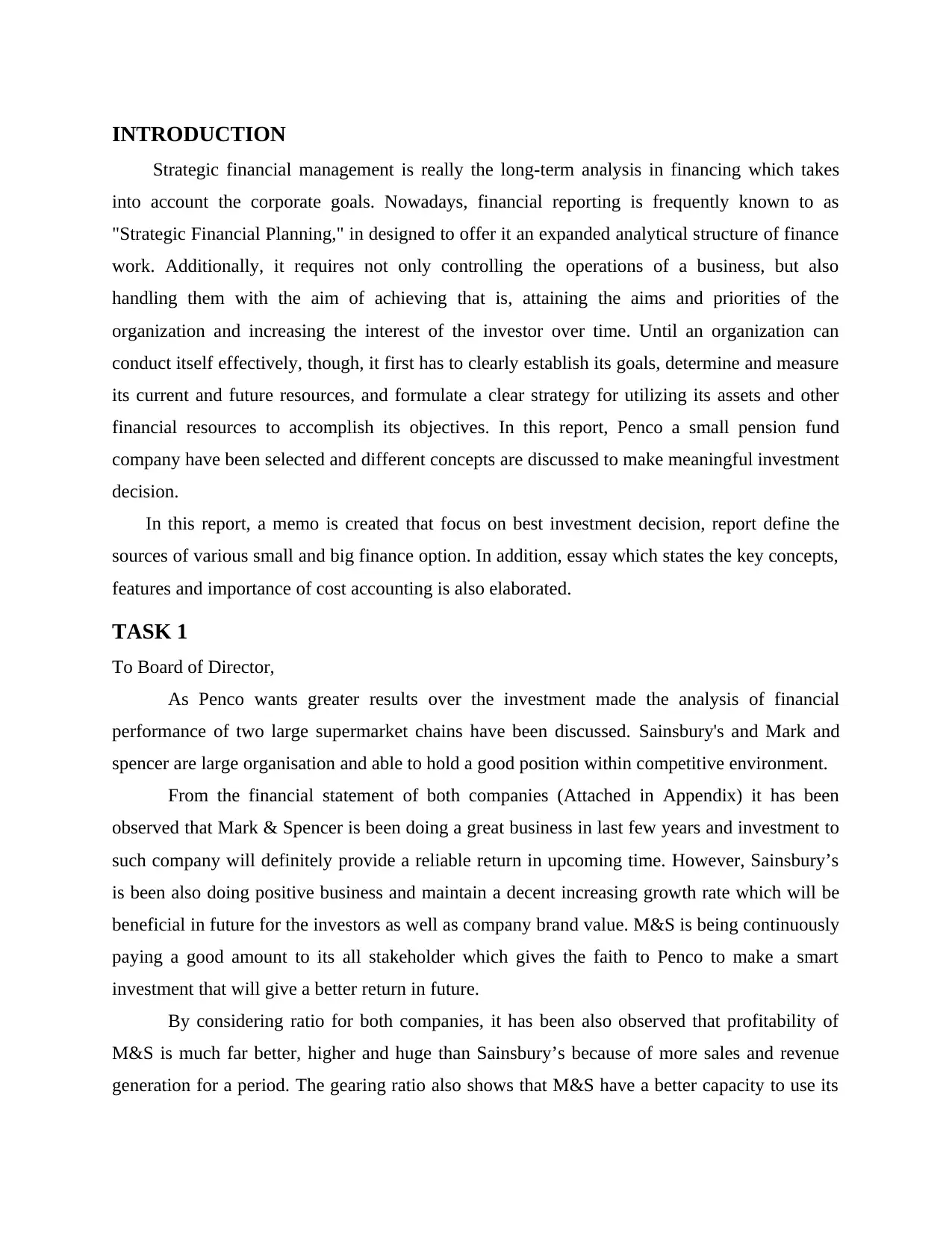
INTRODUCTION
Strategic financial management is really the long-term analysis in financing which takes
into account the corporate goals. Nowadays, financial reporting is frequently known to as
"Strategic Financial Planning," in designed to offer it an expanded analytical structure of finance
work. Additionally, it requires not only controlling the operations of a business, but also
handling them with the aim of achieving that is, attaining the aims and priorities of the
organization and increasing the interest of the investor over time. Until an organization can
conduct itself effectively, though, it first has to clearly establish its goals, determine and measure
its current and future resources, and formulate a clear strategy for utilizing its assets and other
financial resources to accomplish its objectives. In this report, Penco a small pension fund
company have been selected and different concepts are discussed to make meaningful investment
decision.
In this report, a memo is created that focus on best investment decision, report define the
sources of various small and big finance option. In addition, essay which states the key concepts,
features and importance of cost accounting is also elaborated.
TASK 1
To Board of Director,
As Penco wants greater results over the investment made the analysis of financial
performance of two large supermarket chains have been discussed. Sainsbury's and Mark and
spencer are large organisation and able to hold a good position within competitive environment.
From the financial statement of both companies (Attached in Appendix) it has been
observed that Mark & Spencer is been doing a great business in last few years and investment to
such company will definitely provide a reliable return in upcoming time. However, Sainsbury’s
is been also doing positive business and maintain a decent increasing growth rate which will be
beneficial in future for the investors as well as company brand value. M&S is being continuously
paying a good amount to its all stakeholder which gives the faith to Penco to make a smart
investment that will give a better return in future.
By considering ratio for both companies, it has been also observed that profitability of
M&S is much far better, higher and huge than Sainsbury’s because of more sales and revenue
generation for a period. The gearing ratio also shows that M&S have a better capacity to use its
Strategic financial management is really the long-term analysis in financing which takes
into account the corporate goals. Nowadays, financial reporting is frequently known to as
"Strategic Financial Planning," in designed to offer it an expanded analytical structure of finance
work. Additionally, it requires not only controlling the operations of a business, but also
handling them with the aim of achieving that is, attaining the aims and priorities of the
organization and increasing the interest of the investor over time. Until an organization can
conduct itself effectively, though, it first has to clearly establish its goals, determine and measure
its current and future resources, and formulate a clear strategy for utilizing its assets and other
financial resources to accomplish its objectives. In this report, Penco a small pension fund
company have been selected and different concepts are discussed to make meaningful investment
decision.
In this report, a memo is created that focus on best investment decision, report define the
sources of various small and big finance option. In addition, essay which states the key concepts,
features and importance of cost accounting is also elaborated.
TASK 1
To Board of Director,
As Penco wants greater results over the investment made the analysis of financial
performance of two large supermarket chains have been discussed. Sainsbury's and Mark and
spencer are large organisation and able to hold a good position within competitive environment.
From the financial statement of both companies (Attached in Appendix) it has been
observed that Mark & Spencer is been doing a great business in last few years and investment to
such company will definitely provide a reliable return in upcoming time. However, Sainsbury’s
is been also doing positive business and maintain a decent increasing growth rate which will be
beneficial in future for the investors as well as company brand value. M&S is being continuously
paying a good amount to its all stakeholder which gives the faith to Penco to make a smart
investment that will give a better return in future.
By considering ratio for both companies, it has been also observed that profitability of
M&S is much far better, higher and huge than Sainsbury’s because of more sales and revenue
generation for a period. The gearing ratio also shows that M&S have a better capacity to use its
⊘ This is a preview!⊘
Do you want full access?
Subscribe today to unlock all pages.

Trusted by 1+ million students worldwide
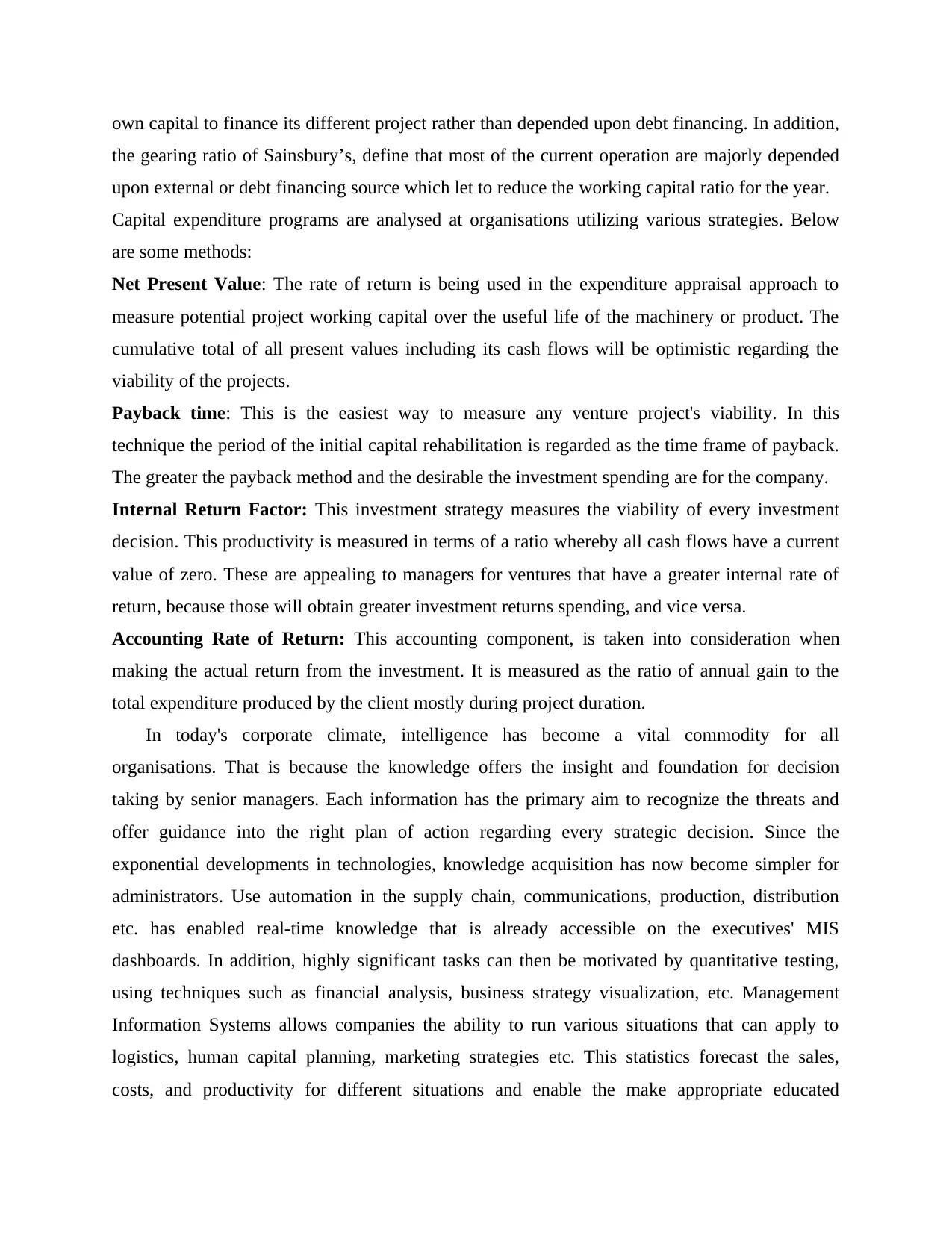
own capital to finance its different project rather than depended upon debt financing. In addition,
the gearing ratio of Sainsbury’s, define that most of the current operation are majorly depended
upon external or debt financing source which let to reduce the working capital ratio for the year.
Capital expenditure programs are analysed at organisations utilizing various strategies. Below
are some methods:
Net Present Value: The rate of return is being used in the expenditure appraisal approach to
measure potential project working capital over the useful life of the machinery or product. The
cumulative total of all present values including its cash flows will be optimistic regarding the
viability of the projects.
Payback time: This is the easiest way to measure any venture project's viability. In this
technique the period of the initial capital rehabilitation is regarded as the time frame of payback.
The greater the payback method and the desirable the investment spending are for the company.
Internal Return Factor: This investment strategy measures the viability of every investment
decision. This productivity is measured in terms of a ratio whereby all cash flows have a current
value of zero. These are appealing to managers for ventures that have a greater internal rate of
return, because those will obtain greater investment returns spending, and vice versa.
Accounting Rate of Return: This accounting component, is taken into consideration when
making the actual return from the investment. It is measured as the ratio of annual gain to the
total expenditure produced by the client mostly during project duration.
In today's corporate climate, intelligence has become a vital commodity for all
organisations. That is because the knowledge offers the insight and foundation for decision
taking by senior managers. Each information has the primary aim to recognize the threats and
offer guidance into the right plan of action regarding every strategic decision. Since the
exponential developments in technologies, knowledge acquisition has now become simpler for
administrators. Use automation in the supply chain, communications, production, distribution
etc. has enabled real-time knowledge that is already accessible on the executives' MIS
dashboards. In addition, highly significant tasks can then be motivated by quantitative testing,
using techniques such as financial analysis, business strategy visualization, etc. Management
Information Systems allows companies the ability to run various situations that can apply to
logistics, human capital planning, marketing strategies etc. This statistics forecast the sales,
costs, and productivity for different situations and enable the make appropriate educated
the gearing ratio of Sainsbury’s, define that most of the current operation are majorly depended
upon external or debt financing source which let to reduce the working capital ratio for the year.
Capital expenditure programs are analysed at organisations utilizing various strategies. Below
are some methods:
Net Present Value: The rate of return is being used in the expenditure appraisal approach to
measure potential project working capital over the useful life of the machinery or product. The
cumulative total of all present values including its cash flows will be optimistic regarding the
viability of the projects.
Payback time: This is the easiest way to measure any venture project's viability. In this
technique the period of the initial capital rehabilitation is regarded as the time frame of payback.
The greater the payback method and the desirable the investment spending are for the company.
Internal Return Factor: This investment strategy measures the viability of every investment
decision. This productivity is measured in terms of a ratio whereby all cash flows have a current
value of zero. These are appealing to managers for ventures that have a greater internal rate of
return, because those will obtain greater investment returns spending, and vice versa.
Accounting Rate of Return: This accounting component, is taken into consideration when
making the actual return from the investment. It is measured as the ratio of annual gain to the
total expenditure produced by the client mostly during project duration.
In today's corporate climate, intelligence has become a vital commodity for all
organisations. That is because the knowledge offers the insight and foundation for decision
taking by senior managers. Each information has the primary aim to recognize the threats and
offer guidance into the right plan of action regarding every strategic decision. Since the
exponential developments in technologies, knowledge acquisition has now become simpler for
administrators. Use automation in the supply chain, communications, production, distribution
etc. has enabled real-time knowledge that is already accessible on the executives' MIS
dashboards. In addition, highly significant tasks can then be motivated by quantitative testing,
using techniques such as financial analysis, business strategy visualization, etc. Management
Information Systems allows companies the ability to run various situations that can apply to
logistics, human capital planning, marketing strategies etc. This statistics forecast the sales,
costs, and productivity for different situations and enable the make appropriate educated
Paraphrase This Document
Need a fresh take? Get an instant paraphrase of this document with our AI Paraphraser
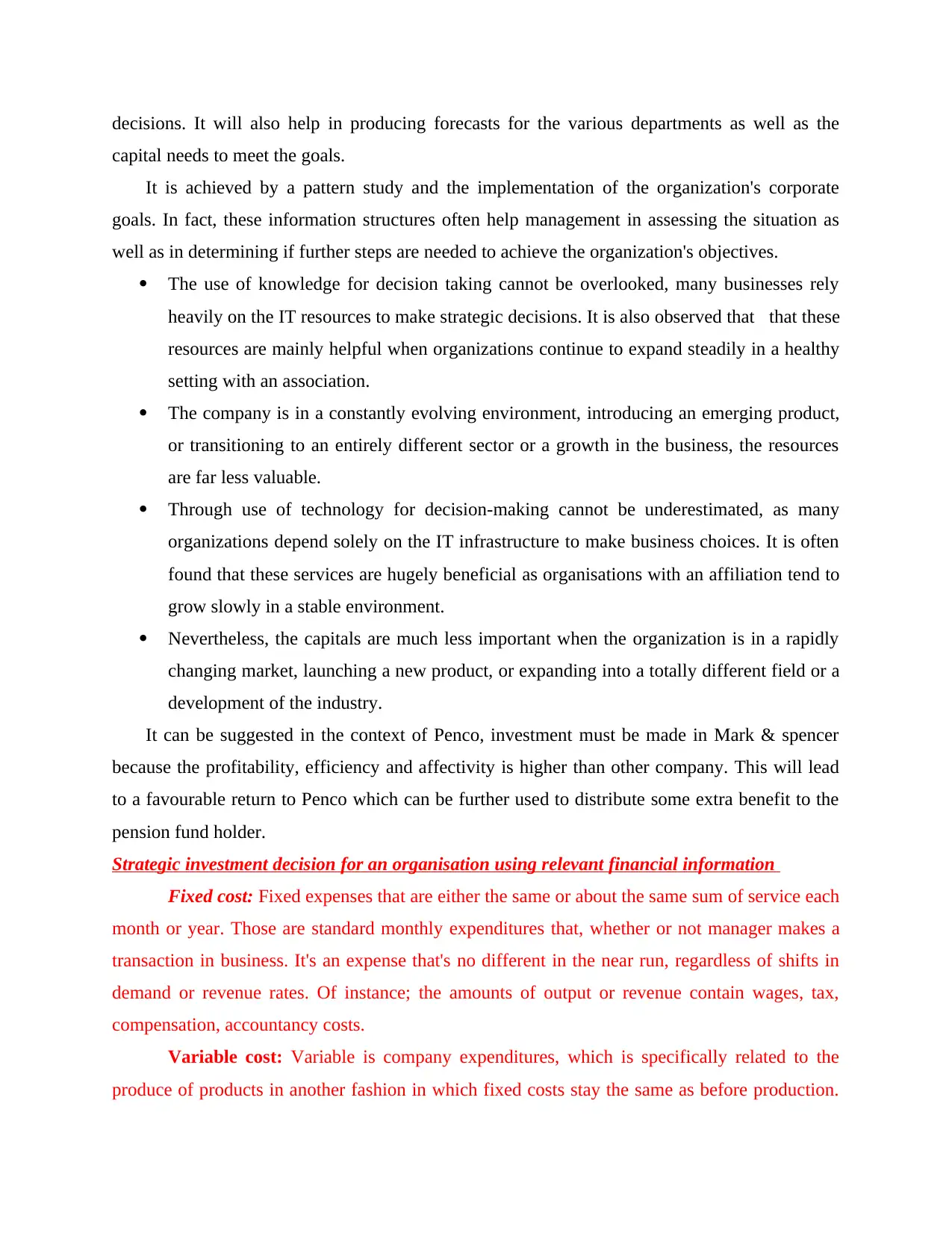
decisions. It will also help in producing forecasts for the various departments as well as the
capital needs to meet the goals.
It is achieved by a pattern study and the implementation of the organization's corporate
goals. In fact, these information structures often help management in assessing the situation as
well as in determining if further steps are needed to achieve the organization's objectives.
The use of knowledge for decision taking cannot be overlooked, many businesses rely
heavily on the IT resources to make strategic decisions. It is also observed that that these
resources are mainly helpful when organizations continue to expand steadily in a healthy
setting with an association.
The company is in a constantly evolving environment, introducing an emerging product,
or transitioning to an entirely different sector or a growth in the business, the resources
are far less valuable.
Through use of technology for decision-making cannot be underestimated, as many
organizations depend solely on the IT infrastructure to make business choices. It is often
found that these services are hugely beneficial as organisations with an affiliation tend to
grow slowly in a stable environment.
Nevertheless, the capitals are much less important when the organization is in a rapidly
changing market, launching a new product, or expanding into a totally different field or a
development of the industry.
It can be suggested in the context of Penco, investment must be made in Mark & spencer
because the profitability, efficiency and affectivity is higher than other company. This will lead
to a favourable return to Penco which can be further used to distribute some extra benefit to the
pension fund holder.
Strategic investment decision for an organisation using relevant financial information
Fixed cost: Fixed expenses that are either the same or about the same sum of service each
month or year. Those are standard monthly expenditures that, whether or not manager makes a
transaction in business. It's an expense that's no different in the near run, regardless of shifts in
demand or revenue rates. Of instance; the amounts of output or revenue contain wages, tax,
compensation, accountancy costs.
Variable cost: Variable is company expenditures, which is specifically related to the
produce of products in another fashion in which fixed costs stay the same as before production.
capital needs to meet the goals.
It is achieved by a pattern study and the implementation of the organization's corporate
goals. In fact, these information structures often help management in assessing the situation as
well as in determining if further steps are needed to achieve the organization's objectives.
The use of knowledge for decision taking cannot be overlooked, many businesses rely
heavily on the IT resources to make strategic decisions. It is also observed that that these
resources are mainly helpful when organizations continue to expand steadily in a healthy
setting with an association.
The company is in a constantly evolving environment, introducing an emerging product,
or transitioning to an entirely different sector or a growth in the business, the resources
are far less valuable.
Through use of technology for decision-making cannot be underestimated, as many
organizations depend solely on the IT infrastructure to make business choices. It is often
found that these services are hugely beneficial as organisations with an affiliation tend to
grow slowly in a stable environment.
Nevertheless, the capitals are much less important when the organization is in a rapidly
changing market, launching a new product, or expanding into a totally different field or a
development of the industry.
It can be suggested in the context of Penco, investment must be made in Mark & spencer
because the profitability, efficiency and affectivity is higher than other company. This will lead
to a favourable return to Penco which can be further used to distribute some extra benefit to the
pension fund holder.
Strategic investment decision for an organisation using relevant financial information
Fixed cost: Fixed expenses that are either the same or about the same sum of service each
month or year. Those are standard monthly expenditures that, whether or not manager makes a
transaction in business. It's an expense that's no different in the near run, regardless of shifts in
demand or revenue rates. Of instance; the amounts of output or revenue contain wages, tax,
compensation, accountancy costs.
Variable cost: Variable is company expenditures, which is specifically related to the
produce of products in another fashion in which fixed costs stay the same as before production.
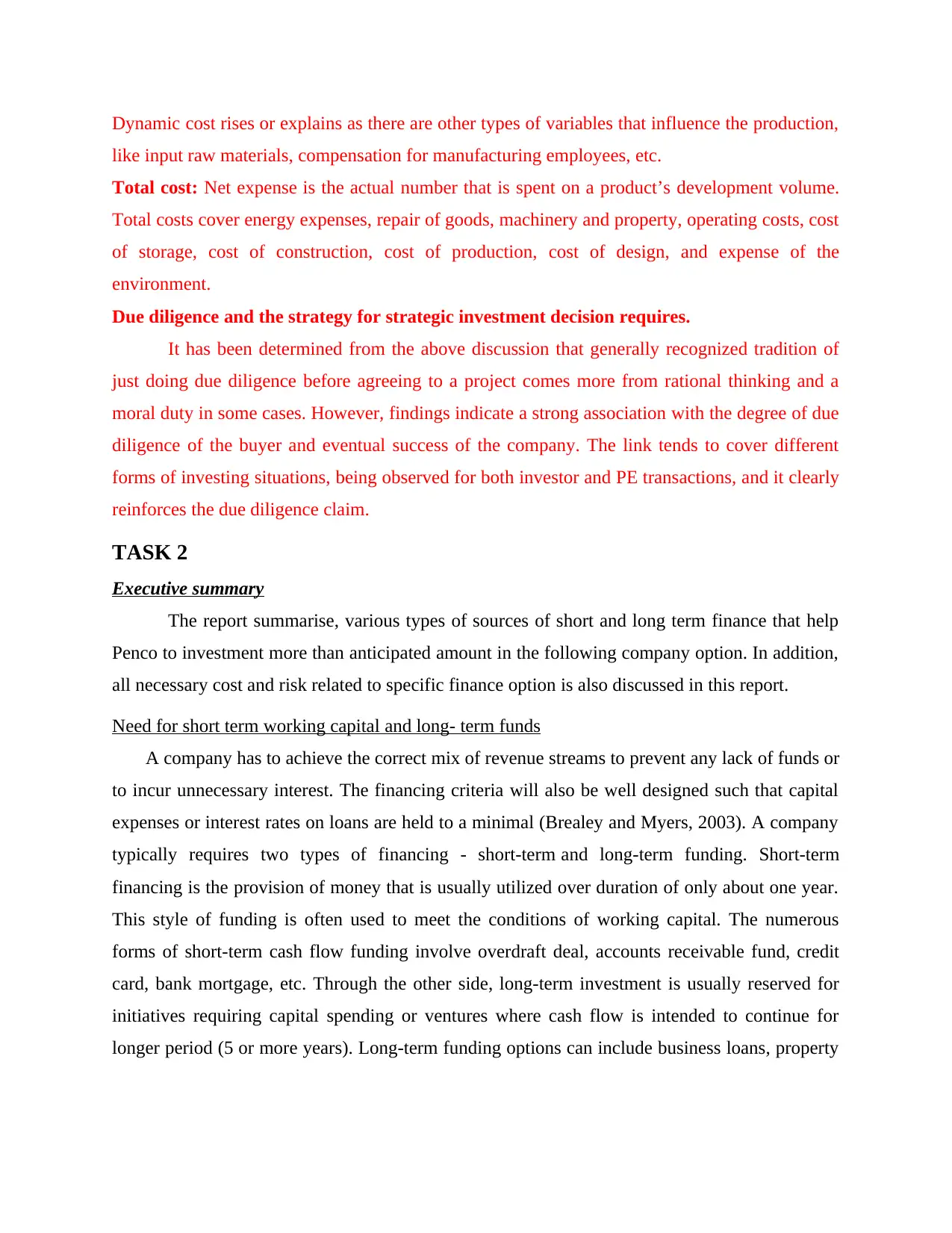
Dynamic cost rises or explains as there are other types of variables that influence the production,
like input raw materials, compensation for manufacturing employees, etc.
Total cost: Net expense is the actual number that is spent on a product’s development volume.
Total costs cover energy expenses, repair of goods, machinery and property, operating costs, cost
of storage, cost of construction, cost of production, cost of design, and expense of the
environment.
Due diligence and the strategy for strategic investment decision requires.
It has been determined from the above discussion that generally recognized tradition of
just doing due diligence before agreeing to a project comes more from rational thinking and a
moral duty in some cases. However, findings indicate a strong association with the degree of due
diligence of the buyer and eventual success of the company. The link tends to cover different
forms of investing situations, being observed for both investor and PE transactions, and it clearly
reinforces the due diligence claim.
TASK 2
Executive summary
The report summarise, various types of sources of short and long term finance that help
Penco to investment more than anticipated amount in the following company option. In addition,
all necessary cost and risk related to specific finance option is also discussed in this report.
Need for short term working capital and long- term funds
A company has to achieve the correct mix of revenue streams to prevent any lack of funds or
to incur unnecessary interest. The financing criteria will also be well designed such that capital
expenses or interest rates on loans are held to a minimal (Brealey and Myers, 2003). A company
typically requires two types of financing - short-term and long-term funding. Short-term
financing is the provision of money that is usually utilized over duration of only about one year.
This style of funding is often used to meet the conditions of working capital. The numerous
forms of short-term cash flow funding involve overdraft deal, accounts receivable fund, credit
card, bank mortgage, etc. Through the other side, long-term investment is usually reserved for
initiatives requiring capital spending or ventures where cash flow is intended to continue for
longer period (5 or more years). Long-term funding options can include business loans, property
like input raw materials, compensation for manufacturing employees, etc.
Total cost: Net expense is the actual number that is spent on a product’s development volume.
Total costs cover energy expenses, repair of goods, machinery and property, operating costs, cost
of storage, cost of construction, cost of production, cost of design, and expense of the
environment.
Due diligence and the strategy for strategic investment decision requires.
It has been determined from the above discussion that generally recognized tradition of
just doing due diligence before agreeing to a project comes more from rational thinking and a
moral duty in some cases. However, findings indicate a strong association with the degree of due
diligence of the buyer and eventual success of the company. The link tends to cover different
forms of investing situations, being observed for both investor and PE transactions, and it clearly
reinforces the due diligence claim.
TASK 2
Executive summary
The report summarise, various types of sources of short and long term finance that help
Penco to investment more than anticipated amount in the following company option. In addition,
all necessary cost and risk related to specific finance option is also discussed in this report.
Need for short term working capital and long- term funds
A company has to achieve the correct mix of revenue streams to prevent any lack of funds or
to incur unnecessary interest. The financing criteria will also be well designed such that capital
expenses or interest rates on loans are held to a minimal (Brealey and Myers, 2003). A company
typically requires two types of financing - short-term and long-term funding. Short-term
financing is the provision of money that is usually utilized over duration of only about one year.
This style of funding is often used to meet the conditions of working capital. The numerous
forms of short-term cash flow funding involve overdraft deal, accounts receivable fund, credit
card, bank mortgage, etc. Through the other side, long-term investment is usually reserved for
initiatives requiring capital spending or ventures where cash flow is intended to continue for
longer period (5 or more years). Long-term funding options can include business loans, property
⊘ This is a preview!⊘
Do you want full access?
Subscribe today to unlock all pages.

Trusted by 1+ million students worldwide
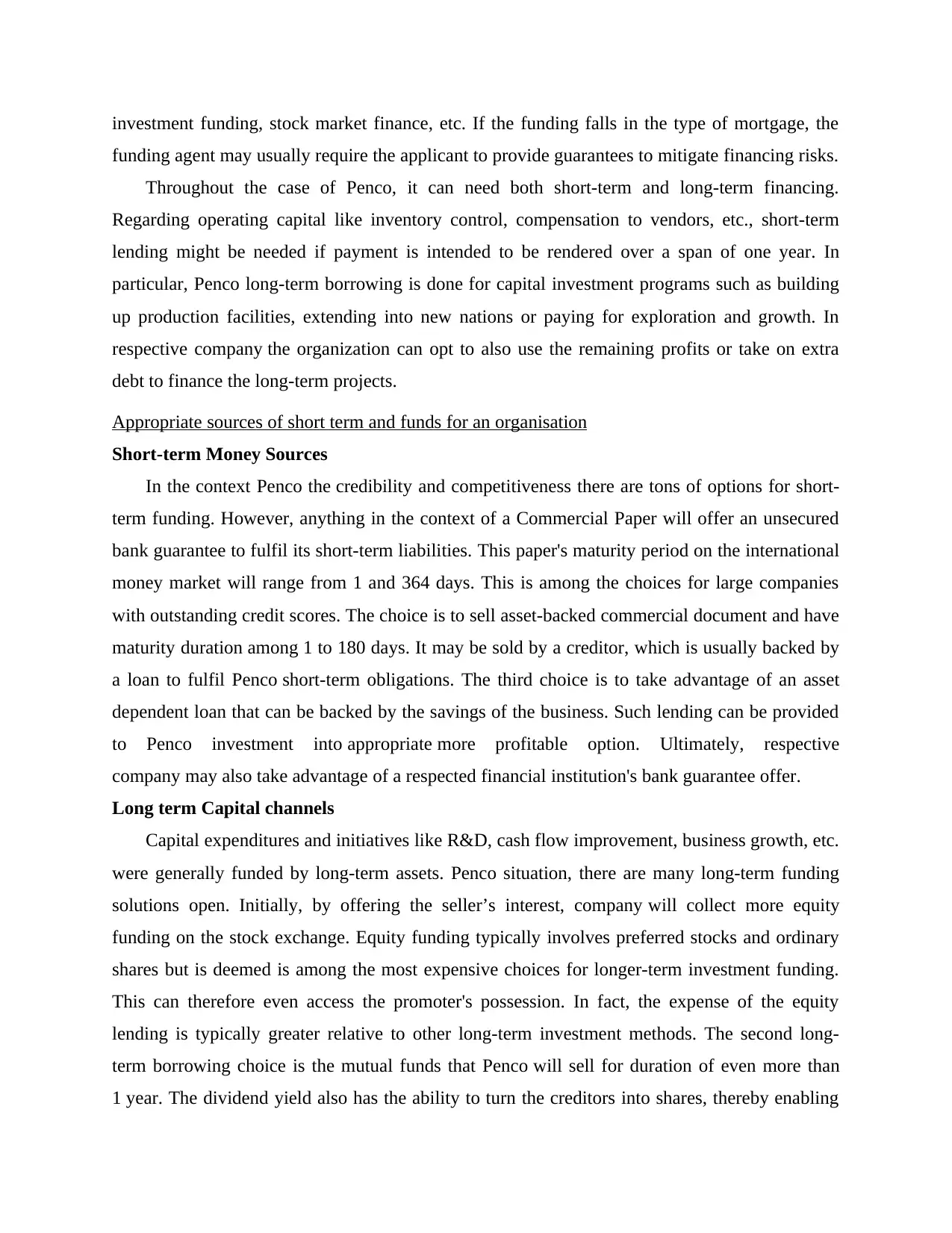
investment funding, stock market finance, etc. If the funding falls in the type of mortgage, the
funding agent may usually require the applicant to provide guarantees to mitigate financing risks.
Throughout the case of Penco, it can need both short-term and long-term financing.
Regarding operating capital like inventory control, compensation to vendors, etc., short-term
lending might be needed if payment is intended to be rendered over a span of one year. In
particular, Penco long-term borrowing is done for capital investment programs such as building
up production facilities, extending into new nations or paying for exploration and growth. In
respective company the organization can opt to also use the remaining profits or take on extra
debt to finance the long-term projects.
Appropriate sources of short term and funds for an organisation
Short-term Money Sources
In the context Penco the credibility and competitiveness there are tons of options for short-
term funding. However, anything in the context of a Commercial Paper will offer an unsecured
bank guarantee to fulfil its short-term liabilities. This paper's maturity period on the international
money market will range from 1 and 364 days. This is among the choices for large companies
with outstanding credit scores. The choice is to sell asset-backed commercial document and have
maturity duration among 1 to 180 days. It may be sold by a creditor, which is usually backed by
a loan to fulfil Penco short-term obligations. The third choice is to take advantage of an asset
dependent loan that can be backed by the savings of the business. Such lending can be provided
to Penco investment into appropriate more profitable option. Ultimately, respective
company may also take advantage of a respected financial institution's bank guarantee offer.
Long term Capital channels
Capital expenditures and initiatives like R&D, cash flow improvement, business growth, etc.
were generally funded by long-term assets. Penco situation, there are many long-term funding
solutions open. Initially, by offering the seller’s interest, company will collect more equity
funding on the stock exchange. Equity funding typically involves preferred stocks and ordinary
shares but is deemed is among the most expensive choices for longer-term investment funding.
This can therefore even access the promoter's possession. In fact, the expense of the equity
lending is typically greater relative to other long-term investment methods. The second long-
term borrowing choice is the mutual funds that Penco will sell for duration of even more than
1 year. The dividend yield also has the ability to turn the creditors into shares, thereby enabling
funding agent may usually require the applicant to provide guarantees to mitigate financing risks.
Throughout the case of Penco, it can need both short-term and long-term financing.
Regarding operating capital like inventory control, compensation to vendors, etc., short-term
lending might be needed if payment is intended to be rendered over a span of one year. In
particular, Penco long-term borrowing is done for capital investment programs such as building
up production facilities, extending into new nations or paying for exploration and growth. In
respective company the organization can opt to also use the remaining profits or take on extra
debt to finance the long-term projects.
Appropriate sources of short term and funds for an organisation
Short-term Money Sources
In the context Penco the credibility and competitiveness there are tons of options for short-
term funding. However, anything in the context of a Commercial Paper will offer an unsecured
bank guarantee to fulfil its short-term liabilities. This paper's maturity period on the international
money market will range from 1 and 364 days. This is among the choices for large companies
with outstanding credit scores. The choice is to sell asset-backed commercial document and have
maturity duration among 1 to 180 days. It may be sold by a creditor, which is usually backed by
a loan to fulfil Penco short-term obligations. The third choice is to take advantage of an asset
dependent loan that can be backed by the savings of the business. Such lending can be provided
to Penco investment into appropriate more profitable option. Ultimately, respective
company may also take advantage of a respected financial institution's bank guarantee offer.
Long term Capital channels
Capital expenditures and initiatives like R&D, cash flow improvement, business growth, etc.
were generally funded by long-term assets. Penco situation, there are many long-term funding
solutions open. Initially, by offering the seller’s interest, company will collect more equity
funding on the stock exchange. Equity funding typically involves preferred stocks and ordinary
shares but is deemed is among the most expensive choices for longer-term investment funding.
This can therefore even access the promoter's possession. In fact, the expense of the equity
lending is typically greater relative to other long-term investment methods. The second long-
term borrowing choice is the mutual funds that Penco will sell for duration of even more than
1 year. The dividend yield also has the ability to turn the creditors into shares, thereby enabling
Paraphrase This Document
Need a fresh take? Get an instant paraphrase of this document with our AI Paraphraser
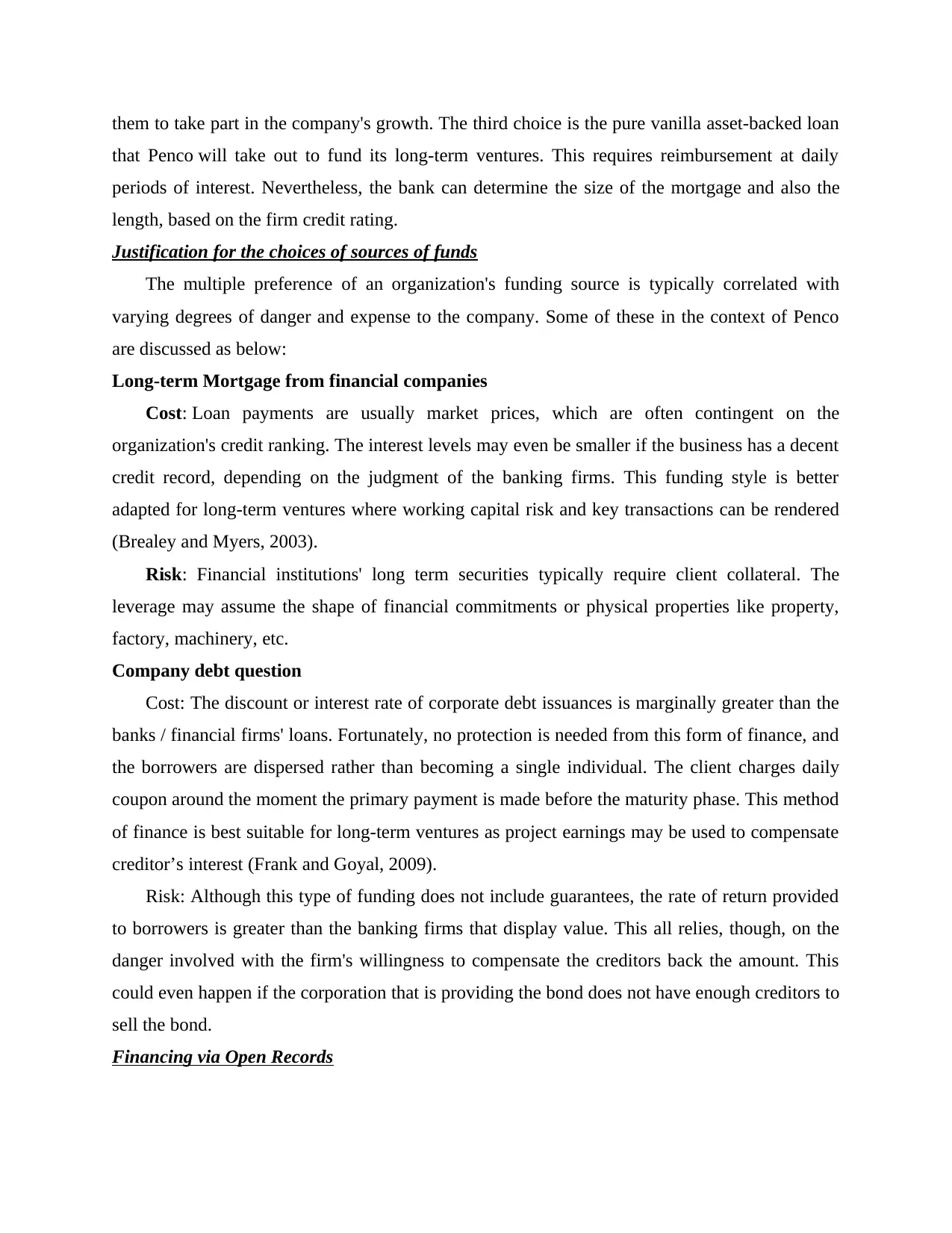
them to take part in the company's growth. The third choice is the pure vanilla asset-backed loan
that Penco will take out to fund its long-term ventures. This requires reimbursement at daily
periods of interest. Nevertheless, the bank can determine the size of the mortgage and also the
length, based on the firm credit rating.
Justification for the choices of sources of funds
The multiple preference of an organization's funding source is typically correlated with
varying degrees of danger and expense to the company. Some of these in the context of Penco
are discussed as below:
Long-term Mortgage from financial companies
Cost: Loan payments are usually market prices, which are often contingent on the
organization's credit ranking. The interest levels may even be smaller if the business has a decent
credit record, depending on the judgment of the banking firms. This funding style is better
adapted for long-term ventures where working capital risk and key transactions can be rendered
(Brealey and Myers, 2003).
Risk: Financial institutions' long term securities typically require client collateral. The
leverage may assume the shape of financial commitments or physical properties like property,
factory, machinery, etc.
Company debt question
Cost: The discount or interest rate of corporate debt issuances is marginally greater than the
banks / financial firms' loans. Fortunately, no protection is needed from this form of finance, and
the borrowers are dispersed rather than becoming a single individual. The client charges daily
coupon around the moment the primary payment is made before the maturity phase. This method
of finance is best suitable for long-term ventures as project earnings may be used to compensate
creditor’s interest (Frank and Goyal, 2009).
Risk: Although this type of funding does not include guarantees, the rate of return provided
to borrowers is greater than the banking firms that display value. This all relies, though, on the
danger involved with the firm's willingness to compensate the creditors back the amount. This
could even happen if the corporation that is providing the bond does not have enough creditors to
sell the bond.
Financing via Open Records
that Penco will take out to fund its long-term ventures. This requires reimbursement at daily
periods of interest. Nevertheless, the bank can determine the size of the mortgage and also the
length, based on the firm credit rating.
Justification for the choices of sources of funds
The multiple preference of an organization's funding source is typically correlated with
varying degrees of danger and expense to the company. Some of these in the context of Penco
are discussed as below:
Long-term Mortgage from financial companies
Cost: Loan payments are usually market prices, which are often contingent on the
organization's credit ranking. The interest levels may even be smaller if the business has a decent
credit record, depending on the judgment of the banking firms. This funding style is better
adapted for long-term ventures where working capital risk and key transactions can be rendered
(Brealey and Myers, 2003).
Risk: Financial institutions' long term securities typically require client collateral. The
leverage may assume the shape of financial commitments or physical properties like property,
factory, machinery, etc.
Company debt question
Cost: The discount or interest rate of corporate debt issuances is marginally greater than the
banks / financial firms' loans. Fortunately, no protection is needed from this form of finance, and
the borrowers are dispersed rather than becoming a single individual. The client charges daily
coupon around the moment the primary payment is made before the maturity phase. This method
of finance is best suitable for long-term ventures as project earnings may be used to compensate
creditor’s interest (Frank and Goyal, 2009).
Risk: Although this type of funding does not include guarantees, the rate of return provided
to borrowers is greater than the banking firms that display value. This all relies, though, on the
danger involved with the firm's willingness to compensate the creditors back the amount. This
could even happen if the corporation that is providing the bond does not have enough creditors to
sell the bond.
Financing via Open Records
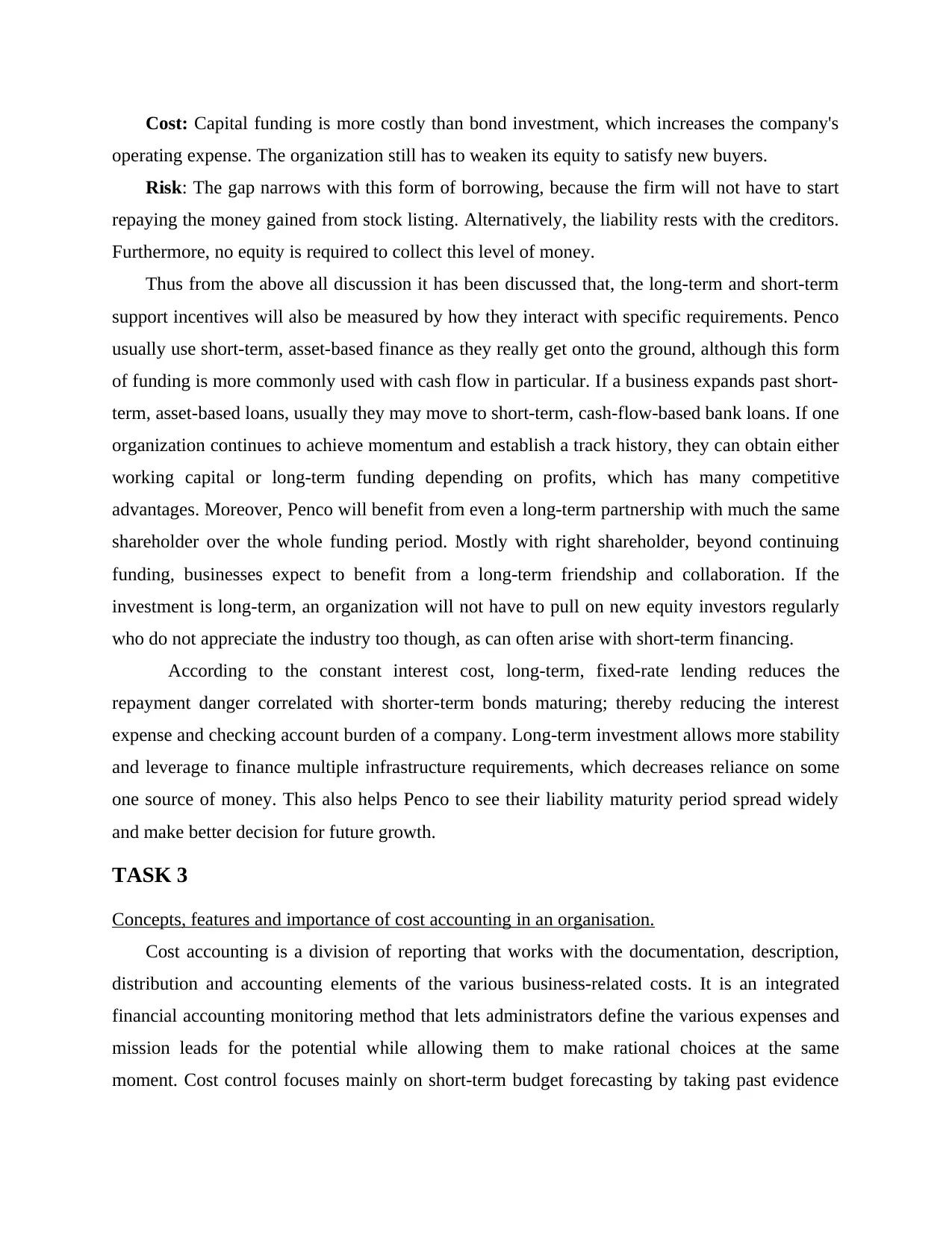
Cost: Capital funding is more costly than bond investment, which increases the company's
operating expense. The organization still has to weaken its equity to satisfy new buyers.
Risk: The gap narrows with this form of borrowing, because the firm will not have to start
repaying the money gained from stock listing. Alternatively, the liability rests with the creditors.
Furthermore, no equity is required to collect this level of money.
Thus from the above all discussion it has been discussed that, the long-term and short-term
support incentives will also be measured by how they interact with specific requirements. Penco
usually use short-term, asset-based finance as they really get onto the ground, although this form
of funding is more commonly used with cash flow in particular. If a business expands past short-
term, asset-based loans, usually they may move to short-term, cash-flow-based bank loans. If one
organization continues to achieve momentum and establish a track history, they can obtain either
working capital or long-term funding depending on profits, which has many competitive
advantages. Moreover, Penco will benefit from even a long-term partnership with much the same
shareholder over the whole funding period. Mostly with right shareholder, beyond continuing
funding, businesses expect to benefit from a long-term friendship and collaboration. If the
investment is long-term, an organization will not have to pull on new equity investors regularly
who do not appreciate the industry too though, as can often arise with short-term financing.
According to the constant interest cost, long-term, fixed-rate lending reduces the
repayment danger correlated with shorter-term bonds maturing; thereby reducing the interest
expense and checking account burden of a company. Long-term investment allows more stability
and leverage to finance multiple infrastructure requirements, which decreases reliance on some
one source of money. This also helps Penco to see their liability maturity period spread widely
and make better decision for future growth.
TASK 3
Concepts, features and importance of cost accounting in an organisation.
Cost accounting is a division of reporting that works with the documentation, description,
distribution and accounting elements of the various business-related costs. It is an integrated
financial accounting monitoring method that lets administrators define the various expenses and
mission leads for the potential while allowing them to make rational choices at the same
moment. Cost control focuses mainly on short-term budget forecasting by taking past evidence
operating expense. The organization still has to weaken its equity to satisfy new buyers.
Risk: The gap narrows with this form of borrowing, because the firm will not have to start
repaying the money gained from stock listing. Alternatively, the liability rests with the creditors.
Furthermore, no equity is required to collect this level of money.
Thus from the above all discussion it has been discussed that, the long-term and short-term
support incentives will also be measured by how they interact with specific requirements. Penco
usually use short-term, asset-based finance as they really get onto the ground, although this form
of funding is more commonly used with cash flow in particular. If a business expands past short-
term, asset-based loans, usually they may move to short-term, cash-flow-based bank loans. If one
organization continues to achieve momentum and establish a track history, they can obtain either
working capital or long-term funding depending on profits, which has many competitive
advantages. Moreover, Penco will benefit from even a long-term partnership with much the same
shareholder over the whole funding period. Mostly with right shareholder, beyond continuing
funding, businesses expect to benefit from a long-term friendship and collaboration. If the
investment is long-term, an organization will not have to pull on new equity investors regularly
who do not appreciate the industry too though, as can often arise with short-term financing.
According to the constant interest cost, long-term, fixed-rate lending reduces the
repayment danger correlated with shorter-term bonds maturing; thereby reducing the interest
expense and checking account burden of a company. Long-term investment allows more stability
and leverage to finance multiple infrastructure requirements, which decreases reliance on some
one source of money. This also helps Penco to see their liability maturity period spread widely
and make better decision for future growth.
TASK 3
Concepts, features and importance of cost accounting in an organisation.
Cost accounting is a division of reporting that works with the documentation, description,
distribution and accounting elements of the various business-related costs. It is an integrated
financial accounting monitoring method that lets administrators define the various expenses and
mission leads for the potential while allowing them to make rational choices at the same
moment. Cost control focuses mainly on short-term budget forecasting by taking past evidence
⊘ This is a preview!⊘
Do you want full access?
Subscribe today to unlock all pages.

Trusted by 1+ million students worldwide
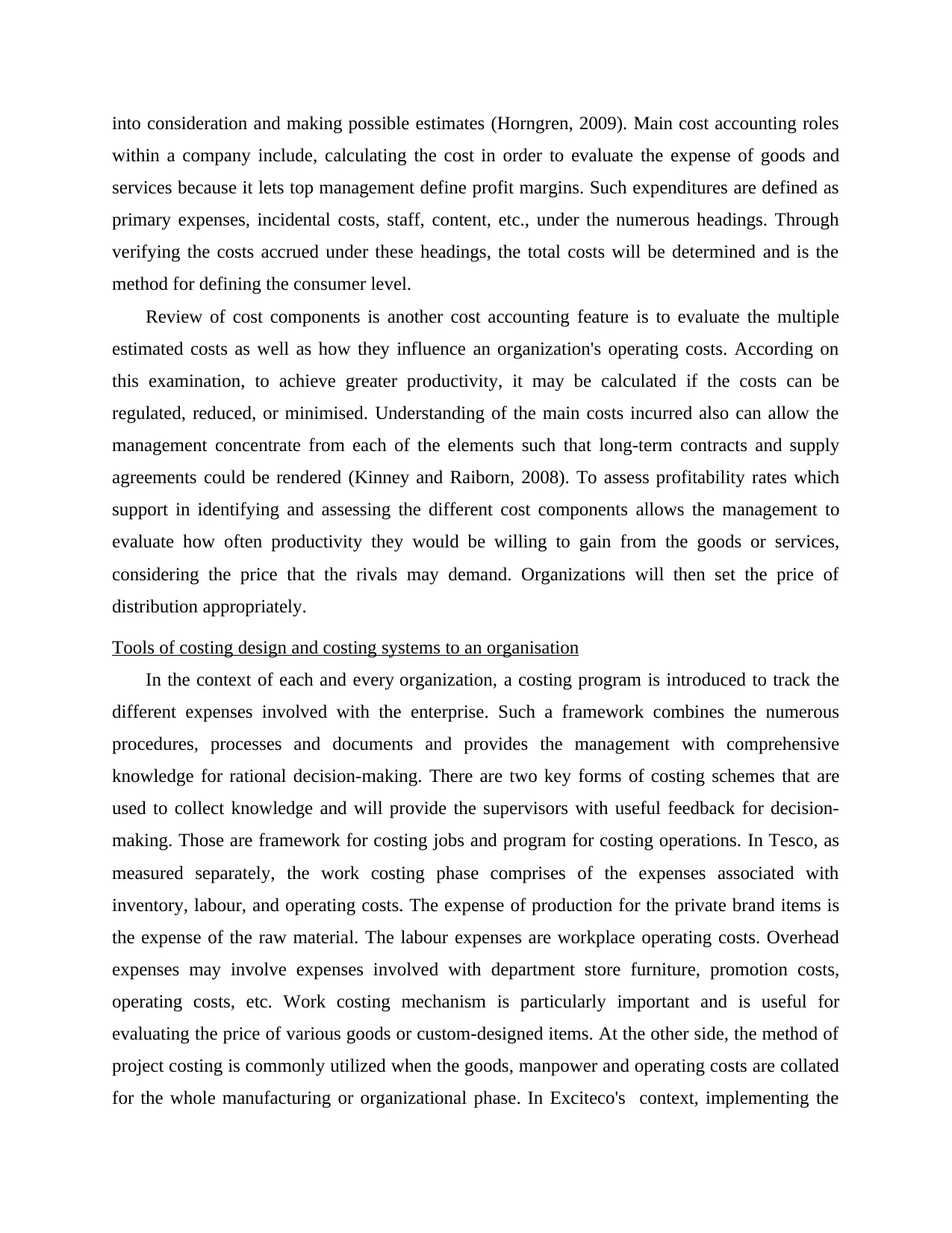
into consideration and making possible estimates (Horngren, 2009). Main cost accounting roles
within a company include, calculating the cost in order to evaluate the expense of goods and
services because it lets top management define profit margins. Such expenditures are defined as
primary expenses, incidental costs, staff, content, etc., under the numerous headings. Through
verifying the costs accrued under these headings, the total costs will be determined and is the
method for defining the consumer level.
Review of cost components is another cost accounting feature is to evaluate the multiple
estimated costs as well as how they influence an organization's operating costs. According on
this examination, to achieve greater productivity, it may be calculated if the costs can be
regulated, reduced, or minimised. Understanding of the main costs incurred also can allow the
management concentrate from each of the elements such that long-term contracts and supply
agreements could be rendered (Kinney and Raiborn, 2008). To assess profitability rates which
support in identifying and assessing the different cost components allows the management to
evaluate how often productivity they would be willing to gain from the goods or services,
considering the price that the rivals may demand. Organizations will then set the price of
distribution appropriately.
Tools of costing design and costing systems to an organisation
In the context of each and every organization, a costing program is introduced to track the
different expenses involved with the enterprise. Such a framework combines the numerous
procedures, processes and documents and provides the management with comprehensive
knowledge for rational decision-making. There are two key forms of costing schemes that are
used to collect knowledge and will provide the supervisors with useful feedback for decision-
making. Those are framework for costing jobs and program for costing operations. In Tesco, as
measured separately, the work costing phase comprises of the expenses associated with
inventory, labour, and operating costs. The expense of production for the private brand items is
the expense of the raw material. The labour expenses are workplace operating costs. Overhead
expenses may involve expenses involved with department store furniture, promotion costs,
operating costs, etc. Work costing mechanism is particularly important and is useful for
evaluating the price of various goods or custom-designed items. At the other side, the method of
project costing is commonly utilized when the goods, manpower and operating costs are collated
for the whole manufacturing or organizational phase. In Exciteco's context, implementing the
within a company include, calculating the cost in order to evaluate the expense of goods and
services because it lets top management define profit margins. Such expenditures are defined as
primary expenses, incidental costs, staff, content, etc., under the numerous headings. Through
verifying the costs accrued under these headings, the total costs will be determined and is the
method for defining the consumer level.
Review of cost components is another cost accounting feature is to evaluate the multiple
estimated costs as well as how they influence an organization's operating costs. According on
this examination, to achieve greater productivity, it may be calculated if the costs can be
regulated, reduced, or minimised. Understanding of the main costs incurred also can allow the
management concentrate from each of the elements such that long-term contracts and supply
agreements could be rendered (Kinney and Raiborn, 2008). To assess profitability rates which
support in identifying and assessing the different cost components allows the management to
evaluate how often productivity they would be willing to gain from the goods or services,
considering the price that the rivals may demand. Organizations will then set the price of
distribution appropriately.
Tools of costing design and costing systems to an organisation
In the context of each and every organization, a costing program is introduced to track the
different expenses involved with the enterprise. Such a framework combines the numerous
procedures, processes and documents and provides the management with comprehensive
knowledge for rational decision-making. There are two key forms of costing schemes that are
used to collect knowledge and will provide the supervisors with useful feedback for decision-
making. Those are framework for costing jobs and program for costing operations. In Tesco, as
measured separately, the work costing phase comprises of the expenses associated with
inventory, labour, and operating costs. The expense of production for the private brand items is
the expense of the raw material. The labour expenses are workplace operating costs. Overhead
expenses may involve expenses involved with department store furniture, promotion costs,
operating costs, etc. Work costing mechanism is particularly important and is useful for
evaluating the price of various goods or custom-designed items. At the other side, the method of
project costing is commonly utilized when the goods, manpower and operating costs are collated
for the whole manufacturing or organizational phase. In Exciteco's context, implementing the
Paraphrase This Document
Need a fresh take? Get an instant paraphrase of this document with our AI Paraphraser
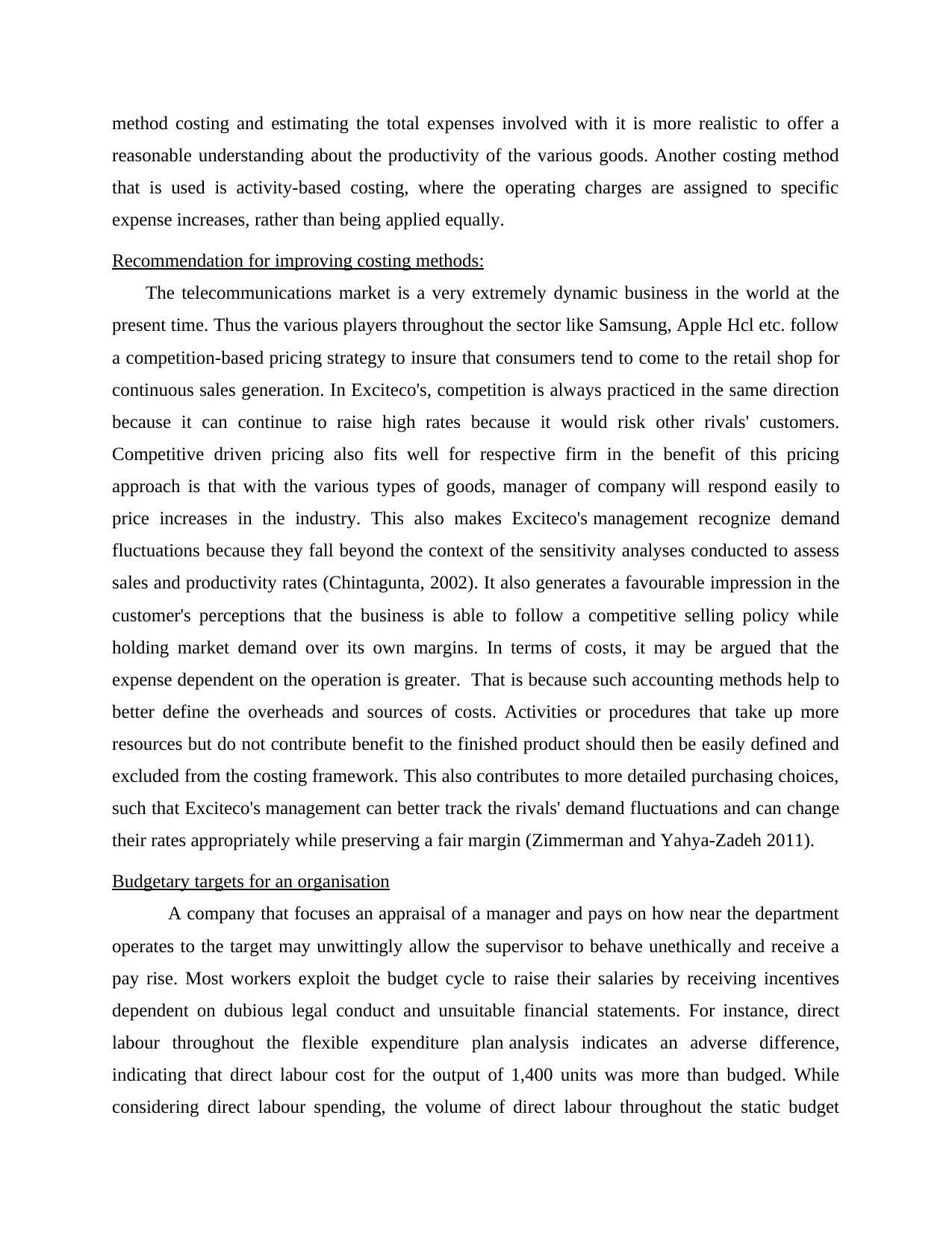
method costing and estimating the total expenses involved with it is more realistic to offer a
reasonable understanding about the productivity of the various goods. Another costing method
that is used is activity-based costing, where the operating charges are assigned to specific
expense increases, rather than being applied equally.
Recommendation for improving costing methods:
The telecommunications market is a very extremely dynamic business in the world at the
present time. Thus the various players throughout the sector like Samsung, Apple Hcl etc. follow
a competition-based pricing strategy to insure that consumers tend to come to the retail shop for
continuous sales generation. In Exciteco's, competition is always practiced in the same direction
because it can continue to raise high rates because it would risk other rivals' customers.
Competitive driven pricing also fits well for respective firm in the benefit of this pricing
approach is that with the various types of goods, manager of company will respond easily to
price increases in the industry. This also makes Exciteco's management recognize demand
fluctuations because they fall beyond the context of the sensitivity analyses conducted to assess
sales and productivity rates (Chintagunta, 2002). It also generates a favourable impression in the
customer's perceptions that the business is able to follow a competitive selling policy while
holding market demand over its own margins. In terms of costs, it may be argued that the
expense dependent on the operation is greater. That is because such accounting methods help to
better define the overheads and sources of costs. Activities or procedures that take up more
resources but do not contribute benefit to the finished product should then be easily defined and
excluded from the costing framework. This also contributes to more detailed purchasing choices,
such that Exciteco's management can better track the rivals' demand fluctuations and can change
their rates appropriately while preserving a fair margin (Zimmerman and Yahya-Zadeh 2011).
Budgetary targets for an organisation
A company that focuses an appraisal of a manager and pays on how near the department
operates to the target may unwittingly allow the supervisor to behave unethically and receive a
pay rise. Most workers exploit the budget cycle to raise their salaries by receiving incentives
dependent on dubious legal conduct and unsuitable financial statements. For instance, direct
labour throughout the flexible expenditure plan analysis indicates an adverse difference,
indicating that direct labour cost for the output of 1,400 units was more than budged. While
considering direct labour spending, the volume of direct labour throughout the static budget
reasonable understanding about the productivity of the various goods. Another costing method
that is used is activity-based costing, where the operating charges are assigned to specific
expense increases, rather than being applied equally.
Recommendation for improving costing methods:
The telecommunications market is a very extremely dynamic business in the world at the
present time. Thus the various players throughout the sector like Samsung, Apple Hcl etc. follow
a competition-based pricing strategy to insure that consumers tend to come to the retail shop for
continuous sales generation. In Exciteco's, competition is always practiced in the same direction
because it can continue to raise high rates because it would risk other rivals' customers.
Competitive driven pricing also fits well for respective firm in the benefit of this pricing
approach is that with the various types of goods, manager of company will respond easily to
price increases in the industry. This also makes Exciteco's management recognize demand
fluctuations because they fall beyond the context of the sensitivity analyses conducted to assess
sales and productivity rates (Chintagunta, 2002). It also generates a favourable impression in the
customer's perceptions that the business is able to follow a competitive selling policy while
holding market demand over its own margins. In terms of costs, it may be argued that the
expense dependent on the operation is greater. That is because such accounting methods help to
better define the overheads and sources of costs. Activities or procedures that take up more
resources but do not contribute benefit to the finished product should then be easily defined and
excluded from the costing framework. This also contributes to more detailed purchasing choices,
such that Exciteco's management can better track the rivals' demand fluctuations and can change
their rates appropriately while preserving a fair margin (Zimmerman and Yahya-Zadeh 2011).
Budgetary targets for an organisation
A company that focuses an appraisal of a manager and pays on how near the department
operates to the target may unwittingly allow the supervisor to behave unethically and receive a
pay rise. Most workers exploit the budget cycle to raise their salaries by receiving incentives
dependent on dubious legal conduct and unsuitable financial statements. For instance, direct
labour throughout the flexible expenditure plan analysis indicates an adverse difference,
indicating that direct labour cost for the output of 1,400 units was more than budged. While
considering direct labour spending, the volume of direct labour throughout the static budget
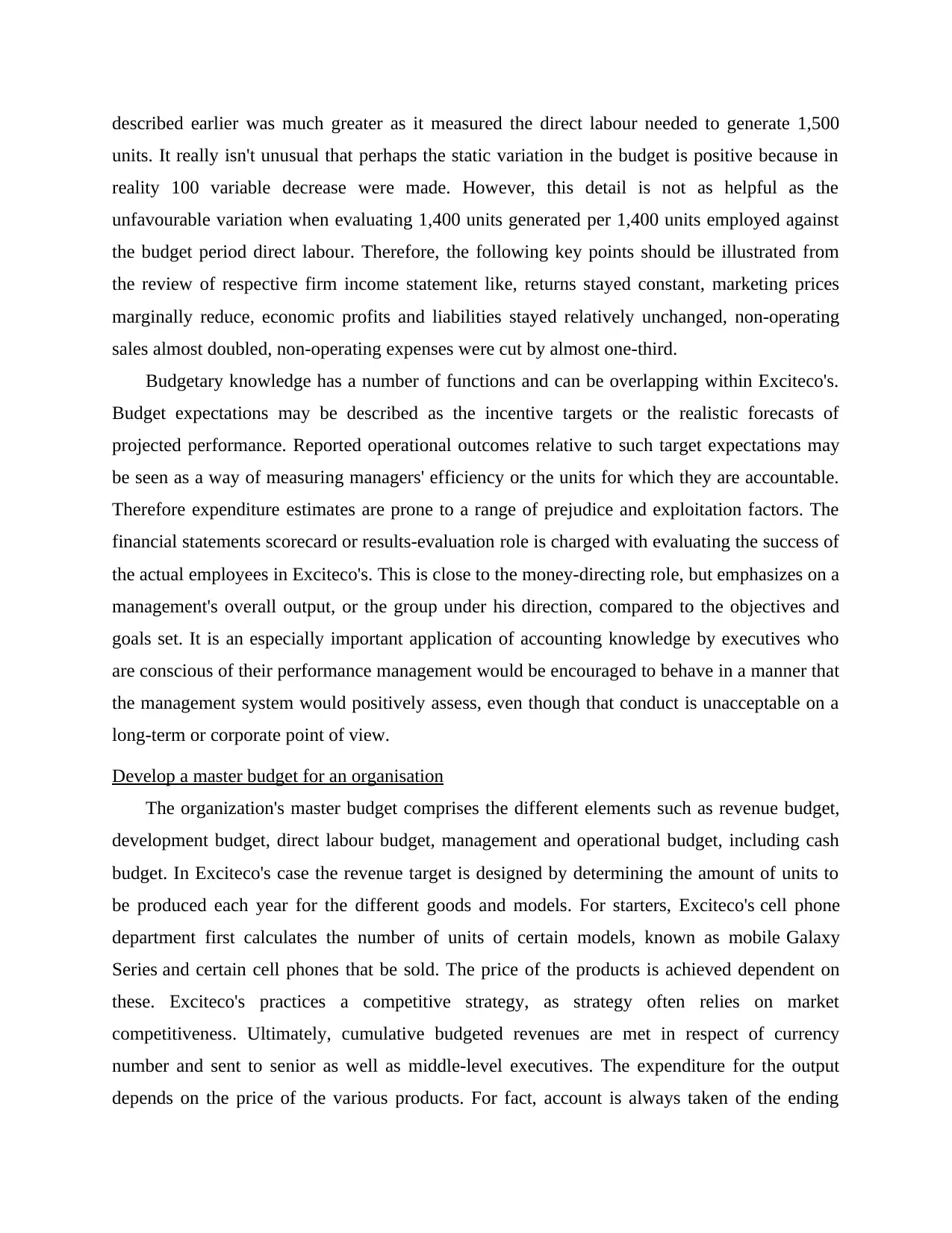
described earlier was much greater as it measured the direct labour needed to generate 1,500
units. It really isn't unusual that perhaps the static variation in the budget is positive because in
reality 100 variable decrease were made. However, this detail is not as helpful as the
unfavourable variation when evaluating 1,400 units generated per 1,400 units employed against
the budget period direct labour. Therefore, the following key points should be illustrated from
the review of respective firm income statement like, returns stayed constant, marketing prices
marginally reduce, economic profits and liabilities stayed relatively unchanged, non-operating
sales almost doubled, non-operating expenses were cut by almost one-third.
Budgetary knowledge has a number of functions and can be overlapping within Exciteco's.
Budget expectations may be described as the incentive targets or the realistic forecasts of
projected performance. Reported operational outcomes relative to such target expectations may
be seen as a way of measuring managers' efficiency or the units for which they are accountable.
Therefore expenditure estimates are prone to a range of prejudice and exploitation factors. The
financial statements scorecard or results-evaluation role is charged with evaluating the success of
the actual employees in Exciteco's. This is close to the money-directing role, but emphasizes on a
management's overall output, or the group under his direction, compared to the objectives and
goals set. It is an especially important application of accounting knowledge by executives who
are conscious of their performance management would be encouraged to behave in a manner that
the management system would positively assess, even though that conduct is unacceptable on a
long-term or corporate point of view.
Develop a master budget for an organisation
The organization's master budget comprises the different elements such as revenue budget,
development budget, direct labour budget, management and operational budget, including cash
budget. In Exciteco's case the revenue target is designed by determining the amount of units to
be produced each year for the different goods and models. For starters, Exciteco's cell phone
department first calculates the number of units of certain models, known as mobile Galaxy
Series and certain cell phones that be sold. The price of the products is achieved dependent on
these. Exciteco's practices a competitive strategy, as strategy often relies on market
competitiveness. Ultimately, cumulative budgeted revenues are met in respect of currency
number and sent to senior as well as middle-level executives. The expenditure for the output
depends on the price of the various products. For fact, account is always taken of the ending
units. It really isn't unusual that perhaps the static variation in the budget is positive because in
reality 100 variable decrease were made. However, this detail is not as helpful as the
unfavourable variation when evaluating 1,400 units generated per 1,400 units employed against
the budget period direct labour. Therefore, the following key points should be illustrated from
the review of respective firm income statement like, returns stayed constant, marketing prices
marginally reduce, economic profits and liabilities stayed relatively unchanged, non-operating
sales almost doubled, non-operating expenses were cut by almost one-third.
Budgetary knowledge has a number of functions and can be overlapping within Exciteco's.
Budget expectations may be described as the incentive targets or the realistic forecasts of
projected performance. Reported operational outcomes relative to such target expectations may
be seen as a way of measuring managers' efficiency or the units for which they are accountable.
Therefore expenditure estimates are prone to a range of prejudice and exploitation factors. The
financial statements scorecard or results-evaluation role is charged with evaluating the success of
the actual employees in Exciteco's. This is close to the money-directing role, but emphasizes on a
management's overall output, or the group under his direction, compared to the objectives and
goals set. It is an especially important application of accounting knowledge by executives who
are conscious of their performance management would be encouraged to behave in a manner that
the management system would positively assess, even though that conduct is unacceptable on a
long-term or corporate point of view.
Develop a master budget for an organisation
The organization's master budget comprises the different elements such as revenue budget,
development budget, direct labour budget, management and operational budget, including cash
budget. In Exciteco's case the revenue target is designed by determining the amount of units to
be produced each year for the different goods and models. For starters, Exciteco's cell phone
department first calculates the number of units of certain models, known as mobile Galaxy
Series and certain cell phones that be sold. The price of the products is achieved dependent on
these. Exciteco's practices a competitive strategy, as strategy often relies on market
competitiveness. Ultimately, cumulative budgeted revenues are met in respect of currency
number and sent to senior as well as middle-level executives. The expenditure for the output
depends on the price of the various products. For fact, account is always taken of the ending
⊘ This is a preview!⊘
Do you want full access?
Subscribe today to unlock all pages.

Trusted by 1+ million students worldwide
1 out of 17
Related Documents
Your All-in-One AI-Powered Toolkit for Academic Success.
+13062052269
info@desklib.com
Available 24*7 on WhatsApp / Email
![[object Object]](/_next/static/media/star-bottom.7253800d.svg)
Unlock your academic potential
Copyright © 2020–2025 A2Z Services. All Rights Reserved. Developed and managed by ZUCOL.




